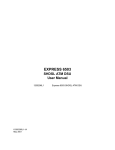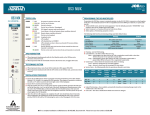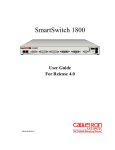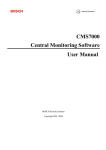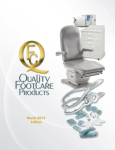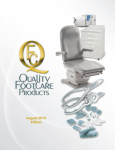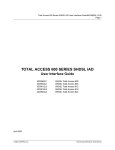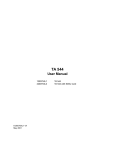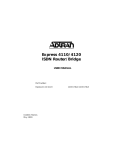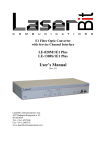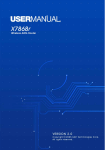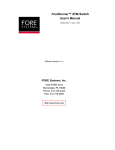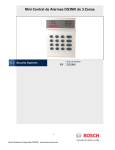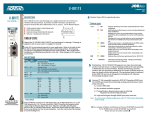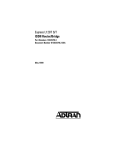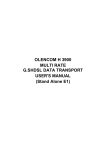Download Express 6503 SHDSL ATM DSU User Manual
Transcript
EXPRESS 6503 SHDSL ATM DSU User Manual 1200296L1 61200296L1-1C November 2002 Express 6503 Trademarks Any brand names and product names included in this manual are trademarks, registered trademarks, or trade names of their respective holders. To the Holder of the Manual The contents of this manual are current as of the date of publication. ADTRAN reserves the right to change the contents without prior notice. In no event will ADTRAN be liable for any special, incidental, or consequential damages or for commercial losses even if ADTRAN has been advised thereof as a result of issue of this publication. 901 Explorer Boulevard P.O. Box 140000 Huntsville, AL 35814-4000 Phone: (256) 963-8000 ©2002 ADTRAN, Inc. All Rights Reserved. Printed in U.S.A. 61200296L1-1C © 2002 ADTRAN, Inc. 2 Notes provide additional useful information. Cautions signify information that could prevent service interruption. Warnings provide information that could prevent damage to the equipment or endangerment to human life. Safety Instructions When using your telephone equipment, please follow these basic safety precautions to reduce the risk of fire, electrical shock, or personal injury: 1. Do not use this product near water, such as a bathtub, wash bowl, kitchen sink, laundry tub, in a wet basement, or near a swimming pool. 2. Avoid using a telephone (other than a cordless-type) during an electrical storm. There is a remote risk of shock from lightning. 3. Do not use the telephone to report a gas leak in the vicinity of the leak. 4. Use only the power cord, power supply, and/or batteries indicated in the manual. Do not dispose of batteries in a fire. They may explode. Check with local codes for special disposal instructions. Save These Important Safety Instructions 3 © 2002 ADTRAN, Inc. 61200296L1-1C Affidavit Requirements for Connection to Digital Services • • • An affidavit is required to be given to the telephone company whenever digital terminal equipment without encoded analog content and billing protection is used to transmit digital signals containing encoded analog content which are intended for eventual conversion into voiceband analog signals and transmitted on the network. The affidavit shall affirm that either no encoded analog content or billing information is being transmitted or that the output of the device meets Part 68 encoded analog content or billing protection specifications. End user/customer will be responsible for filing an affidavit with the local exchange carrier when connecting unprotected customer premise equipment (CPE) to 1.544 Mbps or subrate digital services. Until such time as subrate digital terminal equipment is registered for voice applications, the affidavit requirement for subrate services is waived. 61200296L1-1C © 2002 ADTRAN, Inc. 4 Affidavit for Connection of Customer Premises Equipment to 1.544 Mbps and/or Subrate Digital Services For the work to be performed in the certified territory of ___________________ (telco name) State of ________________ County of ________________ I, _______________________ (name), ____________________________________ (business address), ____________________ (telephone number) being duly sworn, state: I have responsibility for the operation and maintenance of the terminal equipment to be connected to 1.544 Mbps and/or ________ subrate digital services. The terminal equipment to be connected complies with Part 68 of the FCC rules except for the encoded analog content and billing protection specifications. With respect to encoded analog content and billing protection: ( ) I attest that all operations associated with the establishment, maintenance, and adjustment of the digital CPE with respect to analog content and encoded billing protection information continuously complies with Part 68 of the FCC Rules and Regulations. ( ) The digital CPE does not transmit digital signals containing encoded analog content or billing information which is intended to be decoded within the telecommunications network. ( ) The encoded analog content and billing protection is factory set and is not under the control of the customer. I attest that the operator(s)/maintainer(s) of the digital CPE responsible for the establishment, maintenance, and adjustment of the encoded analog content and billing information has (have) been trained to perform these functions by successfully having completed one of the following (check appropriate blocks): ( ) A. A training course provided by the manufacturer/grantee of the equipment used to encode analog signals; or ( ) B. A training course provided by the customer or authorized representative, using training materials and instructions provided by the manufacturer/grantee of the equipment used to encode analog signals; or ( ) C. An independent training course (e.g., trade school or technical institution) recognized by the manufacturer/grantee of the equipment used to encode analog signals; or ( ) D. In lieu of the preceding training requirements, the operator(s)/maintainer(s) is (are) under the control of a supervisor trained in accordance with _________ (circle one) above. 5 © 2002 ADTRAN, Inc. 61200296L1-1C I agree to provide ______________________ (telco’s name) with proper documentation to demonstrate compliance with the information as provided in the preceding paragraph, if so requested. _________________________________Signature _________________________________Title _________________________________ Date Transcribed and sworn to before me This ________ day of _______________, _______ _________________________________ Notary Public My commission expires: _________________________________ 61200296L1-1C © 2002 ADTRAN, Inc. 6 FCC regulations require that the following information be provided in this manual: 1. This equipment complies with Part 68 of FCC rules. On the back of the equipment housing is a label showing the FCC registration number and ringer equivalence number (REN). If requested, provide this information to the telephone company. 2. If this equipment causes harm to the telephone network, the telephone company may temporarily discontinue service. If possible, advance notification is given; otherwise, notification is given as soon as possible. The telephone company will advise the customer of the right to file a complaint with the FCC. 3. The telephone company may make changes in its facilities, equipment, operations, or procedures that could affect the proper operation of this equipment. Advance notification and the opportunity to maintain uninterrupted service are given. 4. If experiencing difficulty with this equipment, please contact ADTRAN for repair and warranty information. The telephone company may require this equipment to be disconnected from the network until the problem is corrected or it is certain the equipment is not malfunctioning. 5. This unit contains no user-serviceable parts. 6. An FCC compliant telephone cord with a modular plug is provided with this equipment. This equipment is designed to be connected to the telephone network or premises wiring using an FCC compatible modular jack, which is Part 68 compliant. 7. The following information may be required when applying to the local telephone company for a dial-up line for the V.34 modem: Service Type REN FIC USOC Loop Start 1.6B/0.8A 02LS2 RJ-11C 8. The REN is useful in determining the quantity of devices you may connect to your telephone line and still have all of those devices ring when your number is called. In most areas, the sum of the RENs of all devices should not exceed five. To be certain of the number of devices you may connect to your line as determined by the REN, call your telephone company to determine the maximum REN for your calling area. 9. This equipment may not be used on coin service provided by the telephone company. Connection to party lines is subject to state tariffs. Contact your state public utility commission or corporation commission for information. 7 © 2002 ADTRAN, Inc. 61200296L1-1C Federal Communications Commission Radio Frequency Interference Statement This equipment has been tested and found to comply with the limits for a Class A digital device, pursuant to Part 15 of the FCC Rules. These limits are designed to provide reasonable protection against harmful interference when the equipment is operated in a commercial environment. This equipment generates, uses, and can radiate radio frequency energy and, if not installed and used in accordance with the instruction manual, may cause harmful interference to radio frequencies. Operation of this equipment in a residential area is likely to cause harmful interference in which case the user will be required to correct the interference at his own expense. Shielded cables must be used with this unit to ensure compliance with Class A FCC limits. Changes or modifications to this unit not expressly approved by the party responsible for compliance could void the user’s authority to operate the equipment. 61200296L1-1C © 2002 ADTRAN, Inc. 8 Industry Canada Compliance Information Notice: The Industry Canada label applied to the product (identified by the Industry Canada logo or the “IC:” in front of the certification/registration number) signifies that the Industry Canada technical specifications were met. Notice: The Ringer Equivalence Number (REN) for this terminal equipment is supplied in the documentation or on the product labeling/markings. The REN assigned to each terminal device indicates the maximum number of terminals that can be connected to a telephone interface. The termination on an interface may consist of any combination of devices subject only to the requirement that the sum of the RENs of all the devices should not exceed five (5). Canadian Emissions Requirements This digital apparatus does not exceed the Class A limits for radio noise emissions from digital apparatus as set out in the interference-causing equipment standard entitled “Digital Apparatus,” ICES-003 of the Department of Communications. Cet appareil numérique respecte les limites de bruits radioelectriques applicables aux appareils numériques de Class A prescrites dans la norme sur le materiel brouilleur: “Appareils Numériques,” NMB-003 edictee par le ministre des Communications. 9 © 2002 ADTRAN, Inc. 61200296L1-1C Warranty and Customer Service ADTRAN will repair and return this product within WARRANTY LENGTH years from the date of shipment if it does not meet its published specifications or fails while in service. For detailed warranty, repair, and return information refer to the ADTRAN Equipment Warranty and Repair and Return Policy Procedure. Return Material Authorization (RMA) is required prior to returning equipment to ADTRAN. For service, RMA requests, or further information, contact one of the numbers listed at the end of this section. LIMITED PRODUCT WARRANTY ADTRAN warrants that for WARRANTY LENGTH years from the date of shipment to Customer, all products manufactured by ADTRAN will be free from defects in materials and workmanship. ADTRAN also warrants that products will conform to the applicable specifications and drawings for such products, as contained in the Product Manual or in ADTRAN's internal specifications and drawings for such products (which may or may not be reflected in the Product Manual). This warranty only applies if Customer gives ADTRAN written notice of defects during the warranty period. Upon such notice, ADTRAN will, at its option, either repair or replace the defective item. If ADTRAN is unable, in a reasonable time, to repair or replace any equipment to a condition as warranted, Customer is entitled to a full refund of the purchase price upon return of the equipment to ADTRAN. This warranty applies only to the original purchaser and is not transferable without ADTRAN's express written permission. This warranty becomes null and void if Customer modifies or alters the equipment in any way, other than as specifically authorized by ADTRAN. EXCEPT FOR THE LIMITED WARRANTY DESCRIBED ABOVE, THE FOREGOING CONSTITUTES THE SOLE AND EXCLUSIVE REMEDY OF THE CUSTOMER AND THE EXCLUSIVE LIABILITY OF ADTRAN AND IS IN LIEU OF ANY AND ALL OTHER WARRANTIES (EXPRESSED OR IMPLIED). ADTRAN SPECIFICALLY DISCLAIMS ALL OTHER WARRANTIES, INCLUDING (WITHOUT LIMITATION), ALL WARRANTIES OF MERCHANTABILITY AND FITNESS FOR A PARTICULAR PURPOSE. SOME STATES DO NOT ALLOW THE EXCLUSION OF IMPLIED WARRANTIES, SO THIS EXCLUSION MAY NOT APPLY TO CUSTOMER. In no event will ADTRAN or its suppliers be liable to the Customer for any incidental, special, punitive, exemplary or consequential damages experienced by either the Customer or a third party (including, but not limited to, loss of data or information, loss of profits, or loss of use). ADTRAN is not liable for damages for any cause whatsoever (whether based in contract, tort, or otherwise) in excess of the amount paid for the item. Some states do not allow the limitation or exclusion of liability for incidental or consequential damages, so the above limitation or exclusion may not apply to the Customer. 61200296L1-1C © 2002 ADTRAN, Inc. 10 Customer Service, Product Support Information, and Training ADTRAN will repair and return this product if within WARRANTY LENGTH years from the date of shipment the product does not meet its published specification or the product fails while in service. A return material authorization (RMA) is required prior to returning equipment to ADTRAN. For service, RMA requests, training, or more information, use the contact information given below. Repair and Return If you determine that a repair is needed, please contact our Customer and Product Service (CAPS) department to have an RMA number issued. CAPS should also be contacted to obtain information regarding equipment currently in house or possible fees associated with repair. CAPS Department (256) 963-8722 Identify the RMA number clearly on the package (below address), and return to the following address: ADTRAN Customer and Product Service 901 Explorer Blvd. (East Tower) Huntsville, Alabama 35806 RMA # _____________ Pre-Sales Inquiries and Applications Support Your reseller should serve as the first point of contact for support. If additional pre-sales support is needed, the ADTRAN Support web site provides a variety of support services such as a searchable knowledge base, latest product documentation, application briefs, case studies, and a link to submit a question to an Applications Engineer. All of this, and more, is available at: http://support.adtran.com When needed, further pre-sales assistance is available by calling our Applications Engineering Department. Applications Engineering (800) 615-1176 11 © 2002 ADTRAN, Inc. 61200296L1-1C Post-Sale Support Your reseller should serve as the first point of contact for support. If additional support is needed, the ADTRAN Support web site provides a variety of support services such as a searchable knowledge base, updated firmware releases, latest product documentation, service request ticket generation and trouble-shooting tools. All of this, and more, is available at: http://support.adtran.com When needed, further post-sales assistance is available by calling our Technical Support Center. Please have your unit serial number available when you call. Technical Support (888) 4ADTRAN Installation and Maintenance Support The ADTRAN Custom Extended Services (ACES) program offers multiple types and levels of installation and maintenance services which allow you to choose the kind of assistance you need. This support is available at: http://www.adtran.com/aces For questions, call the ACES Help Desk. ACES Help Desk (888) 874-ACES (2237) Training The Enterprise Network (EN) Technical Training Department offers training on our most popular products. These courses include overviews on product features and functions while covering applications of ADTRAN's product lines. ADTRAN provides a variety of training options, including customized training and courses taught at our facilities or at your site. For more information about training, please contact your Territory Manager or the Enterprise Training Coordinator. 61200296L1-1C Training Phone (800) 615-1176, ext. 7500 Training Fax (256) 963-6700 Training Email [email protected] © 2002 ADTRAN, Inc. 12 CONTENTS Express 6503 Overview . . . . . . . . . . . . . . . . . . . . . . . . . . . . . . . . . . . . . . . . . . . . . . . . . . . . . . . . . . . 2 Express 6503 Features and Benefits . . . . . . . . . . . . . . . . . . . . . . . . . . . . . . . . . . . . . . . . . . . . . . 2 Front Panel . . . . . . . . . . . . . . . . . . . . . . . . . . . . . . . . . . . . . . . . . . . . . . . . . . . . . . . . . . . . . . . . . . 3 Rear Panel . . . . . . . . . . . . . . . . . . . . . . . . . . . . . . . . . . . . . . . . . . . . . . . . . . . . . . . . . . . . . . . . . . 3 Connector Pinouts. . . . . . . . . . . . . . . . . . . . . . . . . . . . . . . . . . . . . . . . . . . . . . . . . . . . . . . . . . . . . 4 Specifications . . . . . . . . . . . . . . . . . . . . . . . . . . . . . . . . . . . . . . . . . . . . . . . . . . . . . . . . . . . . . . . . . . . 6 Hardware. . . . . . . . . . . . . . . . . . . . . . . . . . . . . . . . . . . . . . . . . . . . . . . . . . . . . . . . . . . . . . . . . . . . 6 Standards Compliance . . . . . . . . . . . . . . . . . . . . . . . . . . . . . . . . . . . . . . . . . . . . . . . . . . . . . . . . . 7 Management . . . . . . . . . . . . . . . . . . . . . . . . . . . . . . . . . . . . . . . . . . . . . . . . . . . . . . . . . . . . . . . . . 7 SHDSL Applications . . . . . . . . . . . . . . . . . . . . . . . . . . . . . . . . . . . . . . . . . . . . . . . . . . . . . . . . . . . . . . 7 Configuring the Express 6503 . . . . . . . . . . . . . . . . . . . . . . . . . . . . . . . . . . . . . . . . . . . . . . . . . . . . . . 9 System Info . . . . . . . . . . . . . . . . . . . . . . . . . . . . . . . . . . . . . . . . . . . . . . . . . . . . . . . . . . . . . . . . . . 9 System Config. . . . . . . . . . . . . . . . . . . . . . . . . . . . . . . . . . . . . . . . . . . . . . . . . . . . . . . . . . . . . . . 11 System Utility . . . . . . . . . . . . . . . . . . . . . . . . . . . . . . . . . . . . . . . . . . . . . . . . . . . . . . . . . . . . . . . 15 System Test . . . . . . . . . . . . . . . . . . . . . . . . . . . . . . . . . . . . . . . . . . . . . . . . . . . . . . . . . . . . . . . . 19 WAN . . . . . . . . . . . . . . . . . . . . . . . . . . . . . . . . . . . . . . . . . . . . . . . . . . . . . . . . . . . . . . . . . . . . . . 19 DTE . . . . . . . . . . . . . . . . . . . . . . . . . . . . . . . . . . . . . . . . . . . . . . . . . . . . . . . . . . . . . . . . . . . . . . . 35 Appendix A. Navigating the Terminal Menus36 Terminal Menu Window . . . . . . . . . . . . . . . . . . . . . . . . . . . . . . . . . . . . . . . . . . . . . . . . . . . . . . . 36 Navigating Using the Keyboard Keys . . . . . . . . . . . . . . . . . . . . . . . . . . . . . . . . . . . . . . . . . . . . . 37 Appendix B. Updating Express 6503 Firmware using XMODEM40 FIGURES Figure 1. Figure 2. Figure 3. Figure 4. Figure 5. Figure 6. Figure 7. Figure 8. Figure 9. Figure 10. Figure 11. Figure 12. Figure 13. Figure 14. Figure 15. Figure 16. Express 6503 Front Panel . . . . . . . . . . . . . . . . . . . . . . . . . . . . . . . . . . . . . . . . . . . . . . . . 3 Rear Panel . . . . . . . . . . . . . . . . . . . . . . . . . . . . . . . . . . . . . . . . . . . . . . . . . . . . . . . . . . . . 4 FRF5 Application . . . . . . . . . . . . . . . . . . . . . . . . . . . . . . . . . . . . . . . . . . . . . . . . . . . . . . . 7 FRF8 Application . . . . . . . . . . . . . . . . . . . . . . . . . . . . . . . . . . . . . . . . . . . . . . . . . . . . . . . 8 LDM Application . . . . . . . . . . . . . . . . . . . . . . . . . . . . . . . . . . . . . . . . . . . . . . . . . . . . . . . . 8 System Information Menu . . . . . . . . . . . . . . . . . . . . . . . . . . . . . . . . . . . . . . . . . . . . . . . . 9 System Configuration Menu . . . . . . . . . . . . . . . . . . . . . . . . . . . . . . . . . . . . . . . . . . . . . . 11 Maintenance Port Menu . . . . . . . . . . . . . . . . . . . . . . . . . . . . . . . . . . . . . . . . . . . . . . . . . 13 System Utility Menu . . . . . . . . . . . . . . . . . . . . . . . . . . . . . . . . . . . . . . . . . . . . . . . . . . . . 15 System Tests Menu . . . . . . . . . . . . . . . . . . . . . . . . . . . . . . . . . . . . . . . . . . . . . . . . . . . . 19 ATM Config Menu . . . . . . . . . . . . . . . . . . . . . . . . . . . . . . . . . . . . . . . . . . . . . . . . . . . . . 25 ATM Stats Menu . . . . . . . . . . . . . . . . . . . . . . . . . . . . . . . . . . . . . . . . . . . . . . . . . . . . . . 26 Wan Sub Menu . . . . . . . . . . . . . . . . . . . . . . . . . . . . . . . . . . . . . . . . . . . . . . . . . . . . . . . 28 SHDSL Config/Stats Menu. . . . . . . . . . . . . . . . . . . . . . . . . . . . . . . . . . . . . . . . . . . . . . . 29 DTE Select/Config Menu . . . . . . . . . . . . . . . . . . . . . . . . . . . . . . . . . . . . . . . . . . . . . . . . 35 Top-level Terminal Menu Window . . . . . . . . . . . . . . . . . . . . . . . . . . . . . . . . . . . . . . . . . 36 TABLES Table 1. Table 2. Table 3. Table 4. Table 5. Front Panel LEDs . . . . . . . . . . . . . . . . . . . . . . . . . . . . . . . . . . . . . . . . . . . . . X.21 Interface . . . . . . . . . . . . . . . . . . . . . . . . . . . . . . . . . . . . . . . . . . . . . . . . V.35 Interface . . . . . . . . . . . . . . . . . . . . . . . . . . . . . . . . . . . . . . . . . . . . . . . . Express 6503 Specifications . . . . . . . . . . . . . . . . . . . . . . . . . . . . . . . . . . . . . Express 6503 Power and Environmental Specifications and Approvals . . . . 61200296L1-1C © 2002 ADTRAN, Inc. ...... ...... ...... ...... ...... ....3 ....4 ....5 ....6 ....6 13 User Interface Guide 1. Express 6503 SHDSL ATM DSU User Manual EXPRESS 6503 OVERVIEW The Express 6503 is a serial (DCE) to SHDSL data service unit (DSU) designed for small offices and branch offices to provide cost-effective access to high-speed SHDSL services. The Express 6503 preserves the customer's investment in existing business class routers, allowing them to take advantage of New World applications and Packet Telephony. It offers an economical migration path utilizing ATM and Frame Relay over SHDSL without requiring replacement of existing networking equipment. The Express 6503 provides small offices and branch offices with fast, affordable, and easy-to-use access to the Internet and corporate network. The Express 6503 makes DSL services and applications accessible to the office router or to the desktop. It supports an integrated SHDSL WAN interface and a serial interface to the router and can operate at symmetric speeds of up to 2312 kbps. On the Express 6503, the terminal menu is the access point to all other operations. Each terminal menu item has several functions and submenus that identify and provide access to specific operations and parameters. These menu selections are described later in this User Interface Guide (pages 18 and following). See Appendix A. Navigating the Terminal Menus on page 48 for instructions about navigating the terminal menus. Express 6503 Features and Benefits • • • • • • • • • • 14 SHDSL WAN Support (ITU-T G.991.2) - The Express 6503 supports serial full duplex bidirectional data transport of up to 2312 kbps. ITU G.hs (ITU-T G.994.1) Support TC PAM Line Encoding - Compliant with the SHDSL standard. Back-to-back operation for Campus LAN applications. Synchronous Serial Interface - The serial interface can support either V.35 or X.21 protocols. AAL5 ATM Adaptation Layer Type 5 Support. FRF.8 Frame Relay to ATM Interworking Support - The Express 6503 supports FRF.8 Frame/ATM service interworking. It maps Frame data-link connection identifiers (DLCIs) to ATM permanent virtual circuits (PVCs); up to four VCs can be configured in the Express 6503. FRF.5 Frame Relay to ATM Interworking Support - DLCIs can be assigned automatically or provisioned. Management Support - The Express 6503 is managed through a command-line interface accessible locally through the management serial port or remotely through Layer 3 in-band management features. Safety and Compliance - The Express 6503 is designed for worldwide safety and electromagnetic certifications (EMC). © 2002 ADTRAN, Inc. 61200296L1-1C Express 6503 SHDSL ATM DSU User Manual User Interface Guide Front Panel Figure 1 shows the Express 6503 front panel, which contains eight LEDs. Table 1 describes these LEDs. PWR NET ALM TEST TD RD RS CS 4 Express 6503 Figure 1. Express 6503 Front Panel Table 1. Front Panel LEDs LABEL PWR COLOR DESCRIPTION Green Power Indication Green On solid to indicate the ATM interface is ready to pass data. Fast blinking to indicate that the network is training. Slow blinking to indicate DSL layer is up. ALM Red Indication of Network not ready. TEST Amber Indication of test in progress. TD Green Transmit Data (TxD) RD Green Receive Data (RxD) RS Green Request to Send CS Green Clear to Send NET Rear Panel The Express 6503 rear panel (Figure 2) contains the following connectors: NETWORK SHDSL interface X.21 serial interface V.35 serial interface CRAFT management/control 90-240/VAC 50/60Hz .1A power input 61200296L1-1C © 2002 ADTRAN, Inc. 15 User Interface Guide Express 6503 SHDSL ATM DSU User Manual V.35 NETWORK CRAFT X.21 90-240VAC 50/60Hz .1A Figure 2. Rear Panel Connector Pinouts Table 2 below and Table 3 on page 17 give the pinouts for the V.35 and X.21 connectors. Table 2. X.21 Interface Pin Name I/O Description 1 Shield I/O Shield for cable 2 TD-A I Transmitted Data 3 RTS-A I Request to Send 4 RD-A O Received Data 5 CD-A O Carrier Detect 6 CLK-A O Signal Timing 7 ETC-A I External Transmit Clock 8 SG I/O Signal Ground 9 TD-B I Transmit Data (return) 10 RTS-B I Request To Send (return) 11 RD-B O Receive Data (return) 12 CD-B O Carrier Detect (return) 13 CLK-B O Signal Timing (return) 14 ETC-B I External Transmit Clock (return) 15 NC N/A No Connection I= Input, O= Output, N/A= Not Applicable 16 © 2002 ADTRAN, Inc. 61200296L1-1C Express 6503 SHDSL ATM DSU User Manual User Interface Guide Table 3. V.35 Interface Pin Name I/O Description A Shield I/O Shield for cable B SG I/O Signal Ground C RTS I Request To Send D CTS O Clear To Send E DSR O Data Set Ready F CD O Carrier Detect H DTR I Data Terminal Ready J* RI O Ring Indicator P SD-A I Send Data R RD-A O Receive Data S SD-B I Send Data (return) T RD-B O Receive Data (return) U TC-A I External Transmit Clock V RC-A O Receive Clock W TC-B I External Transmit Clock (return) X RC-B O Receive Clock (return) Y ST-A O Send Timing AA ST-B O Send Timing (return) K,L NC N/A No Connection M,N NC N/A No Connection BB NC N/A No Connection CC NC N/A No Connection DD NC N/A No Connection EE NC N/A No Connection FF NC N/A No Connection HH NC N/A No Connection JJ NC N/A No Connection KK NC N/A No Connection LL NC N/A No Connection MM NC N/A No Connection NN NC N/A No Connection *Pin J (ring indicator) is needed for most video conferencing applications. I= Input, O= Output, N/A= Not Applicable 61200296L1-1C © 2002 ADTRAN, Inc. 17 User Interface Guide 2. Express 6503 SHDSL ATM DSU User Manual SPECIFICATIONS Hardware Table 4. Express 6503 Specifications Characteristic Description SHDSL Interface SHDSL (ITU-T G.991.2),TCPAM encoding: 200-2312 kbps (3-36 DS0s) RJ-45 connector, unshielded twisted pair copper wire ATM PVCs Up to 4 VPI/VCI mappings User Interface V.35 or X.21 serial interface Protocols/Standards Supported ATM Forum UNI 3.1, ITU-TI.432 Frame Relay Forum FRF.8, FRF. 5 Data Rate 200 - 2312 kbps Flash memory 8 Megabits DRAM 64 Megabits Power Source 110-240 VAC, 50-60 Hz G.handshake G.hs (ITU-T G.994.1) for rate negotiation Table 5. Express 6503 Power and Environmental Specifications and Approvals Characteristic Description AC input voltage 110-240 VAC AC input current ~.1 Amps Operating Temperature Range 32 to 122 deg F (0 to 50 deg C) Operating humidity Humidity: 5 to 90% noncondensing Power Requirements 110-240 VAC @ ~.1 Amps Dimensions (H x W x D) 1.5 in. x 9.0 in. x 6.25 in. Weight (average shipping) 1.5 lbs (0.68 kg) FCC Part 15, Class B EN55022, CISPR 22, Class B Regulatory Approvals UL/CUL 1950 3rd edition and Compliance TS001:1997 S043:2001 CE marked for EMC and safety 18 © 2002 ADTRAN, Inc. 61200296L1-1C Express 6503 SHDSL ATM DSU User Manual User Interface Guide Standards Compliance • • ATM Forum Frame Relay FRF.5 and FRF.8 Management • 3. Command Line Interface SHDSL APPLICATIONS Figure 3 below, Figure 4 on page 20, and Figure 5 on page 20 show some typical applications for the Express 6503. LAN FR Router V.35/X.21 Serial Interface Express 6503 PWR NET ALM TEST TD RD RS CS 4 Express 6503 ATM G.shdsl SCU DS3MX 1181015L1 1181020L1 POWER STATUS TEST HD-10 BRI Mux HD-10 BRI Mux HD-10 BRI Mux HD-10 BRI Mux QFC-C QFC-C QFC-C QFC-C DS3MX 1181200L1 1181020L1 POWER STATUS TEST MODE 1181200L1 1181200L1 FSE ALM ACO LOCKOUT C ON LINE LOCKOUT ON LINE R A APS APS F TEST/ TEST/ ENABLE ENABLE T 1181200L1 1181300L1 1181300L1 1181300L1 T1-OR T1-OR T1-OR T1-OR POWER POWER POWER POWER DSX DSX DSX DSX LBK LBK LBK LBK 1 1 1 1 2 2 2 2 3 3 3 3 4 4 4 4 5 5 5 5 6 6 6 6 7 7 7 7 DSX 8 8 8 8 TST TST TST TST M O N 9 ALM M O N 9 ALM M O N 9 ALM M O N 9 ALM RX RX RX RX SELECT HST ACO 10 10 10 10 DSL DSL DSL DSL 1181310L1 1181300L1 1181310L1 PWR + DSX #1 DSX #1 DSX #1 #2 DSX #2 DSX #2 DSX #2 #3 DSX #3 DSX #3 DSX #3 #4 DSX #4 DSX #4 DSX #4 ACT A ACT P GRN = NORM YEL = MAN S 6V A ACT P GRN = NORM YEL = MAN S A ACT P GRN = NORM YEL = MAN S GRN = NORM YEL = MAN – + T R X X 6V – TX R X 6V – R X 6V – T R X X A ACT A ACT A ACT P P P P S GRN = NORM YEL = MAN S HTU-C 1181101L1 PWR 1181101L1 1181101L1 1181101L1 1181101L1 1181101L1 1181101L1 1181101L1 PWR 1181101L1 1181101L1 DSX TST LP1 HTU-C PWR DSX TST LP1 HTU-C PWR DSX TST LP1 HTU-C 1181101L1 DSX TST LP1 HTU-C PWR DSX TST LP1 HTU-C PWR DSX TST LP1 HTU-C PWR DSX TST LP1 HTU-C PWR DSX TST LP1 HTU-C PWR DSX TST LP1 HTU-C PWR DSX TST LP1 HTU-C PWR DSX TST TST LP1 LP1 LP2 LP2 LP2 LP2 LP2 LP2 LP2 LP2 LP2 LP2 LP2 ALM LP2 ALM ALM ALM ALM ALM ALM ALM ALM ALM ALM ALM TX TX TX TX TX TX TX TX TX TX TX TX RX TX RX RX RX RX RX RX RX RX RX RX RX RX TX TX TX TX TX TX TX TX TX TX TX TX TX TX E Q E Q E Q S M O N RX A ACT S GRN = NORM YEL = MAN 1181101L1 DSX LP2 ALM TX RX M O N P S HTU-C PWR LP1 LP2 ALM E Q E Q E Q E Q E Q E Q E Q E Q E Q E Q E Q TX A GRN = NORM YEL = MAN 1181101L1 TST LP1 + T X TX DSX TST ALM + T X TX PWR DSX LP ALM PWR #1 DSX HTU-C 1181101L1 PWR LBK LP ALM HTU-C 1181310L1 DSX LBK LP ALM PWR DSX LBK LP PWR PWR DSX LBK PWR 1181310L1 PWR DSX PWR DSX DSX GRN = NORM YEL = MAN M O N RX M O N RX M O N RX M O N RX M O N RX M O N RX M O N RX M O N RX M O N RX M O N RX M O N RX M O N RX RX ACT ACT ACT ACT ACT ACT ACT ACT ACT ACT ACT ACT ACT ACT GRN=NORM YEL=MAN GRN=NORM YEL=MAN GRN=NORM YEL=MAN GRN=NORM YEL=MAN GRN=NORM YEL=MAN GRN=NORM YEL=MAN GRN=NORM YEL=MAN GRN=NORM YEL=MAN GRN=NORM YEL=MAN GRN=NORM YEL=MAN GRN=NORM YEL=MAN GRN=NORM YEL=MAN GRN=NORM YEL=MAN GRN=NORM YEL=MAN ATM Network SCU DS3MX 1181015L1 1181020L1 DS3MX 1181020L1 POWER POWER STATUS STATUS TEST TEST LOCKOUT LOCKOUT ON LINE ON LINE HD-10 BRI Mux HD-10 BRI Mux HD-10 BRI Mux HD-10 BRI Mux QFC-C QFC-C QFC-C QFC-C 1181200L1 MODE 1181200L1 FSE ALM ACO C R A APS APS TEST/ TEST/ ENABLE ENABLE 1181200L1 1181300L1 POWER POWER POWER DSX DSX DSX DSX LBK LBK LBK LBK 1 1 1 1 2 2 2 2 3 3 3 3 4 4 4 4 5 5 5 5 6 6 6 6 7 7 7 7 DSX 8 8 8 8 TST 9 F T 1181200L1 POWER SELECT HST ACO 9 9 9 10 10 10 10 DSL DSL DSL DSL 1181300L1 1181300L1 T1-OR T1-OR 1181310L1 1181300L1 PWR + #1 DSX #1 DSX #1 DSX #2 DSX #2 DSX #2 #3 DSX #3 DSX #3 DSX #3 #4 DSX #4 DSX #4 DSX #4 ACT 6V TST ALM A ACT P GRN = NORM YEL = MAN S TST ALM A ACT P GRN = NORM YEL = MAN S ALM A ACT P GRN = NORM YEL = MAN 1181310L1 PWR S GRN = NORM YEL = MAN – R X 6V – R X 6V – + R X 6V – TX M O N M O N RX RX RX T R X X RX A ACT A ACT A ACT P P P P S S GRN = NORM YEL = MAN S GRN = NORM YEL = MAN S GRN = NORM YEL = MAN S GRN = NORM YEL = MAN HTU-C 1181101L1 PWR HTU-C 1181101L1 PWR DSX 1181101L1 1181101L1 LP2 LP2 LP2 ALM ALM ALM TX TX TX RX RX RX TX TX TX TX E Q E Q M O N RX ACT GRN=NORM YEL=MAN E Q M O N GRN=NORM YEL=MAN GRN=NORM YEL=MAN GRN=NORM YEL=MAN HTU-C 1181101L1 1181101L1 1181101L1 TST LP1 LP2 LP2 ALM TX E Q TX E Q E Q RX TX RX TX M O N TX M O N RX 1181101L1 DSX LP1 ALM TX RX HTU-C PWR TST LP1 LP2 M O N 1181101L1 DSX TST E Q TX RX HTU-C PWR DSX ALM TX RX M O N RX HTU-C PWR LP1 LP2 E Q TX M O N 1181101L1 TST ALM TX RX TX RX HTU-C DSX LP2 E Q RX M O N PWR LP1 ALM TX E Q TX 1181101L1 TST LP2 ALM TX RX RX HTU-C DSX LP1 LP2 M O N PWR TST LP1 E Q TX 1181101L1 DSX TST ALM TX RX RX HTU-C PWR DSX LP2 M O N RX HTU-C PWR LP1 TX RX ACT ALM E Q RX M O N RX ACT TX E Q M O N RX ACT TST LP1 LP2 ALM TX RX E Q DSX TST LP1 LP2 TX PWR DSX TST LP1 HTU-C PWR DSX TST LP1 HTU-C PWR DSX TST LP1 ALM TX RX RX A ACT P 1181101L1 TST LP2 ALM M O N A HTU-C DSX LP1 ALM T X TX M O N PWR TST LP + T X TX M O N 1181101L1 DSX LBK ALM + T X TX HTU-C PWR DSX LP ALM PWR DSX #2 ALM 1181310L1 LBK LP ALM T1-OR T1-OR DSX LBK LP PWR #1 DSX TST PWR DSX LBK PWR 1181310L1 PWR DSX PWR DSX DSX M O N RX RX ACT ACT ACT ACT ACT ACT ACT ACT ACT ACT GRN=NORM YEL=MAN GRN=NORM YEL=MAN GRN=NORM YEL=MAN GRN=NORM YEL=MAN GRN=NORM YEL=MAN GRN=NORM YEL=MAN GRN=NORM YEL=MAN GRN=NORM YEL=MAN GRN=NORM YEL=MAN GRN=NORM YEL=MAN ATM G.shdsl LAN FR Router V.35/X.21 Serial Interface Express 6503 PWR NET ALM TEST TD RD RS CS 4 Express 6503 Figure 3. FRF5 Application 61200296L1-1C © 2002 ADTRAN, Inc. 19 User Interface Guide LAN Express 6503 SHDSL ATM DSU User Manual ATM Router ATM Network SCU DS3MX 1181015L1 1181020L1 POWER STATUS TEST DS3MX 1181020L1 HD-10 BRI Mux HD-10 BRI Mux HD-10 BRI Mux HD-10 BRI Mux QFC-C QFC-C QFC-C QFC-C POWER STATUS TEST MODE 1181200L1 1181200L1 FSE ALM ACO LOCKOUT C ON LINE LOCKOUT ON LINE R A APS APS F TEST/ TEST/ ENABLE ENABLE T 1181200L1 1181200L1 1181300L1 1181300L1 1181300L1 T1-OR T1-OR T1-OR T1-OR POWER POWER POWER POWER DSX DSX DSX DSX LBK LBK LBK LBK 1 1 1 1 2 2 2 2 3 3 3 3 4 4 4 4 DSX #1 DSX #1 DSX #1 DSX #1 5 5 5 5 DSX #2 DSX #2 DSX #2 DSX #2 6 6 6 6 DSX #3 DSX #3 DSX #3 DSX #3 7 7 7 7 DSX #4 DSX #4 DSX #4 DSX #4 8 8 8 8 TST TST TST TST M O N 9 ALM M O N 9 ALM M O N 9 ALM M O N 9 ALM RX RX RX RX 10 10 10 10 DSL DSL DSL DSL SELECT HST ACO 1181310L1 1181300L1 PWR ACT A ACT P GRN = NORM YEL = MAN S A ACT P GRN = NORM YEL = MAN + 6V S A ACT P GRN = NORM YEL = MAN S GRN = NORM YEL = MAN – + T R X X 6V – R X 6V – + R X 6V – T R X X A ACT A ACT A ACT A ACT P P P P S S GRN = NORM YEL = MAN S 1181101L1 PWR HTU-C 1181101L1 PWR DSX 1181101L1 1181101L1 1181101L1 1181101L1 1181101L1 PWR 1181101L1 1181101L1 1181101L1 1181101L1 DSX TST LP1 HTU-C PWR DSX TST LP1 HTU-C PWR DSX TST LP1 HTU-C PWR DSX TST LP1 HTU-C PWR DSX TST LP1 HTU-C 1181101L1 DSX TST LP1 HTU-C PWR DSX TST LP1 HTU-C PWR DSX TST LP1 HTU-C PWR DSX TST LP1 HTU-C PWR DSX TST LP1 HTU-C PWR DSX TST LP1 TST LP1 LP1 LP2 LP2 LP2 LP2 LP2 LP2 LP2 LP2 LP2 LP2 LP2 ALM LP2 ALM LP2 ALM ALM ALM ALM ALM ALM ALM ALM ALM ALM ALM TX TX TX TX TX TX RX RX RX RX RX RX E Q E Q E Q E Q E Q TX E Q E Q TX TX TX TX TX TX TX RX RX RX RX RX RX RX TX TX TX TX E Q RX E Q E Q E Q GRN = NORM YEL = MAN S TX TX TX TX TX TX TX TX TX TX RX RX RX RX RX RX RX RX RX RX RX M O N P S HTU-C 1181101L1 TST LP2 ALM E Q E Q E Q TX A GRN = NORM YEL = MAN HTU-C DSX LP1 ALM T X TX PWR TST LP + T X TX 1181101L1 DSX LBK ALM PWR TX HTU-C PWR DSX LP ALM 1181310L1 PWR LBK LP ALM 1181310L1 DSX LBK LP PWR PWR DSX LBK PWR 1181310L1 PWR DSX PWR GRN = NORM YEL = MAN M O N M O N M O N M O N M O N M O N M O N M O N M O N M O N M O N M O N RX M O N RX RX ACT ACT ACT ACT ACT ACT ACT ACT ACT ACT ACT ACT ACT ACT GRN=NORM YEL=MAN GRN=NORM YEL=MAN GRN=NORM YEL=MAN GRN=NORM YEL=MAN GRN=NORM YEL=MAN GRN=NORM YEL=MAN GRN=NORM YEL=MAN GRN=NORM YEL=MAN GRN=NORM YEL=MAN GRN=NORM YEL=MAN GRN=NORM YEL=MAN GRN=NORM YEL=MAN GRN=NORM YEL=MAN GRN=NORM YEL=MAN ATM G.shdsl Express 6503 PWR NET ALM TEST TD RD RS CS 4 Express 6503 V.35/X.21 Serial Interface FR Router LAN Figure 4. FRF8 Application Express 6503 Express 6503 DCE Traffic V.35/X.21 Serial Interface G.shdsl PWR NET ALM TEST PWR NET ALM TEST TD RD RS CS TD RD RS CS 4 Express 6503 4 Express 6503 LTU NTU V.35/X.21 Serial Interface DCE Traffic Figure 5. LDM Application 20 © 2002 ADTRAN, Inc. 61200296L1-1C Express 6503 SHDSL ATM DSU User Manual 4. User Interface Guide CONFIGURING THE EXPRESS 6503 System Info The SYSTEM INFO menu provides basic information about the unit and contains data fields for editing information. Figure 6 displays the items available when you select this menu item. Figure 6. System Information Menu >System Name Provides a user-configurable text string for the name of the Express 6503. This name can help you distinguish between different installations. You can enter up to 31 alpha-numeric characters in this field, including spaces and special characters (such as an underbar). This name will appear on the top line of all screens. >System Location Provides a user-configurable text string for the location of the Express 6503. This field is to help you keep track of the actual physical location of the unit. You can enter up to 31 alphanumeric characters in this field, including spaces and special characters (such as an underbar). >System Contact Provides a user-configurable text string for a contact name. You can use this field to enter the name, phone number, or email address of a person responsible for the Express 6503. You can enter up to 31 alpha-numeric characters in this field, including spaces and special characters (such as an underbar). >Unit Name Product-specific name for the Express 6503. >CLEI Code CLEI code for the Express 6503. 61200296L1-1C © 2002 ADTRAN, Inc. 21 User Interface Guide Express 6503 SHDSL ATM DSU User Manual > Part Number ADTRAN part number for the Express 6503. >Serial Number Serial number of the Express 6503. >Firmware Revision Displays the current firmware revision level of the Express 6503. >Bootcode Revision Displays the bootcode revision. >System Uptime Displays the length of time since the Express 6503 reboot. Each time you reset the system, this value resets to 0 days, 0 hours, 0 min, and 0 secs. >Date/Time Displays the current date and time, including seconds. This field can be edited. Enter the time in 24-hour format (such as 23:00:00 for 11:00 pm). Enter the date in mm-dd-yyyy format (for example, 10-30-2001). 22 © 2002 ADTRAN, Inc. 61200296L1-1C Express 6503 SHDSL ATM DSU User Manual User Interface Guide System Config Set up the Express 6503 operational configuration from the SYSTEM C ONFIG menu. Figure 7 shows the items included in this menu. Figure 7. System Configuration Menu >Telnet Access This parameter determines whether the unit allows telnet access over the SHDSL link. The choices are ON and OFF. The factory default setting is ON. >Telnet User List The telnet user list defines the users which are allowed telnet access and the rules governing that access. Name Up to four users can be configured for access to the Express 6503. Each user can be assigned a security level and time out. The name is a text string of the user name for this session. You can enter up to 15 characters in this field. The factory default is no entry in the NAME field. Authen Method The user can be authenticated by selecting: Password The Password field is used to authenticate the user. Radius The Radius client is used for authenticating the user. The factory default is PASSWORD. Password When the authenticating method is password, this text string is used for the password. You can enter up to 15 characters in this field. The factory default setting is no entry in this field. Idle Time (1-255) This sets the amount of time in minutes you can be idle before you are automatically logged off. The factory default is 10 MINUTES. The range is 1-255 MINUTES. 61200296L1-1C © 2002 ADTRAN, Inc. 23 User Interface Guide Express 6503 SHDSL ATM DSU User Manual Level This is the security level granted to the user. The table below gives a brief description of each level. The factory default is 0. Select level... If you want the user to.... 5 Have read-only permission for all menu items - minimum rights 4 Have read permission for all menu items and permission to use test commands 3 Have access to all commands except passwords, flash download, authentication methods, interface configurations, and telnet security levels. 2 Have access to all commands except passwords, flash download, authentication methods, and telnet security levels. 1 Have access to all commands except passwords and telnet security levels. 0 Have permission to edit every menu item, including creating and editing passwords -- maximum rights >SNMP Menu The Express 6503 is an SNMP agent. It can respond to Gets and Sets, and can generate traps. This menu sets up the access, communities, and traps. Access This parameter determines whether the unit allows SNMP management. When set to OFF, SNMP access is denied. When set to ON, the Express 6503 will respond to SNMP managers based on the configuration. The factory default is ON. Communities This list is used to set up to eight SNMP community names that the Express 6503 will allow. Factory default sets the community "public" with "Get" privileges only. Name This is a text string for the community name. You can enter up to 31 characters in this field. The factory default setting is no entry in this field. Privilege The access for this manager can be assigned three levels. The factory default is NONE. None No access is allowed for this community or manager. Get Manager can only read items. Get/Set Manager can read and set items. Manager IP This is the IP address of SNMP manager. If set to 0.0.0.0, any SNMP manager can access the Express 6503 for this community. The factory default is 0.0.0.0. 24 © 2002 ADTRAN, Inc. 61200296L1-1C Express 6503 SHDSL ATM DSU User Manual User Interface Guide Traps This list defines the manager IP and the manager name. Manager Name The Express 6503 can generate SNMP traps. This list allows up to four managers to be listed to receive traps. is the text string describing the name of the entry. It is intended for easy reference and has no bearing on the SNMP trap function. You can enter up to 31 characters in this field. The factory default is no entry in the manager name field. MANAGER NAME Manager IP This is the IP address of the manager that is to receive the traps. The factory default is 0.0.0.0. >Maint Port Menu The Express 6503 VT 100 CRAFT port is located on the rear panel. The setup for this port is under this menu (Figure 8). Figure 8. Maintenance Port Menu Password Protect When set to NO, the maintenance port is not password protected. When YES (def), the Express 6503 will prompt for a password upon startup. Password This is the text string that is used for comparison when password protecting the maintenance port. By default, no password is entered. Passwords are case-sensitive. 61200296L1-1C © 2002 ADTRAN, Inc. 25 User Interface Guide Express 6503 SHDSL ATM DSU User Manual Instructions for Changing Passwords Step Action 1 Select the PASSWORD field—a new PASSWORD field displays. 2 Type the new password in the ENTER field. 3 Type the new password again in the CONFIRM field. The password can contain up to 15 alphanumeric characters. You can also use spaces and special characters in the password. Baud Rate This is the asynchronous rate that the maintenance port will run. The possible values are 300, 1200, 2400, 4800, 9600 (def), 19200, 38400, 57600, and 115200. Data Bits This is the asynchronous bit rate that the maintenance port will run. The possible values are 7 or 8 (def) bits. Parity This is the asynchronous parity that the maintenance port will run. The possible values are NONE (def), ODD, or EVEN. Stop Bits This is the stop bit used for the maintenance port. The possible values are 1 (def), 1.5 or 2. 26 © 2002 ADTRAN, Inc. 61200296L1-1C Express 6503 SHDSL ATM DSU User Manual User Interface Guide System Utility Use the SYSTEM UTILITY menu (Figure 9) to upgrade firmware. Figure 9. System Utility Menu >Upgrade Firmware Updates firmware when Express 6503 enhancements are released. Transfer Method Two transfer methods are available for use in updating the Express 6503. The two methods for upgrading are XMODEM and TFTP. TFTP requires a TFTP server running on the network. The Express 6503 starts a TFTP client function which gets the upgrade code from the TFTP server. Selecting XMODEM will load the upgrade code through the CRAFT port using any PC terminal emulator with xmodem capability. The factory default is TFTP. (See Appendix B. Updating Express 6503 Firmware using XMODEM on page 52 for more information.) TFTP Server Address This is required when the transfer method is TFTP. It is the IP address or domain name (if DNS is configured) of the TFTP server. The factory default is no entry in the TFTP server address field. TFTP Server Filename This is required when the transfer method is TFTP. It is the case-sensitive file name which contains the upgrade code. The factory default is no entry in the TFTP server filename field. Transfer Status This appears when TFTP is used. It displays the status of the transfer as it happens. Any error or success message will be displayed here. 61200296L1-1C © 2002 ADTRAN, Inc. 27 User Interface Guide Express 6503 SHDSL ATM DSU User Manual Start Transfer This activator is used when the configurable items in this menu are complete. Before using START TRANSFER, the Express 6503 should have a valid IP address, subnet mask, and default gateway (if required). Abort Transfer Use this activator to cancel a TFTP transfer in progress. >Config Transfer Sends a file containing the Express 6503 configuration to a PC connected to the CRAFT port using XMODEM protocol or to a file on a TFTP server using the TFTP protocol. CONFIG TRANSFER also lets you save the Express 6503 configuration as a backup file, so you can use the same configuration with multiple Express 6503 units. In addition, CONFIG TRANSFER can retrieve a configuration file from a TFTP server. To support these transfers, ADTRAN delivers a TFTP program with the Express 6503 called TFTP Server. You can configure any PC running Microsoft Windows with this software, and store a configuration file. Before using CONFIG TRANSFER, the Express 6503 should have a valid IP address, subnet mask, and default gateway (if required). Transfer Method Displays the method used to transfer the configuration file to or from a server. XMODEM and TFTP are supported. The factory default setting is TFTP. Transfer Type Only Binary transfers are currently supported. TFTP Server IP Address Specifies the IP address of the TFTP server. Get this number from your system administrator. If using the ADTRAN Utilities TFTP server, this number appears in the TFTP server status window. The factory default value is 0.0.0.0. TFTP Server Filename Defines the name of the configuration file that you transfer to or retrieve from the TFTP server. The default name is 6503.cfg, but you can edit this name. Current Transfer Status Indicates the current status of the update. 28 © 2002 ADTRAN, Inc. 61200296L1-1C Express 6503 SHDSL ATM DSU User Manual User Interface Guide Previous Transfer Status Indicates the status of the previous update. Load and Use Config Retrieves the configuration file specified in the TFTP SERVER FILENAME field from the server. To start this command, enter Y to begin or enter N to cancel. If you execute this command, the Express 6503 retrieves the configuration file, reboots, then restarts using the new configuration. Save Config Remotely Saves the configuration file specified in TFTP SERVER FILENAME to the server identified in TFTP SERVER IP ADDRESS. To start this command, enter Y to begin or enter N to cancel. Before using this command, you must have identified a valid TFTP server in TFTP SERVER IP ADDRESS. >Ping This menu includes the various ping test parameters such as the activator to control the test, host address, packet size, and number of packets. Start/Stop Activator to start and cancel a ping test. Only one ping session can be active at a time. Host Address IP address or domain name (if DNS is configured) of device to receive the ping. The factory default is no entry in the host address field. Size (40-1500) Total size of the ping to send. Range is 40 to 1500 bytes. The default is 64. # of Packets Total packets to send every 2 seconds. Setting this to 0 allows the client to ping continuously. The default is 1. 61200296L1-1C © 2002 ADTRAN, Inc. 29 User Interface Guide Express 6503 SHDSL ATM DSU User Manual # Transmits Total packets sent (read only). # Receives Total packets received (read only). % Loss Percentage loss based on ping returned from host (read only). >Terminal Mode The terminal mode gives the user a command-line prompt. From this prompt, you can: • • • • 30 Perform a reset with the command "reset." Perform a factory restore with the command "fact restore." Configure the unit. The Express 6503 has the ability to download a text file which contains the configuration of the entire unit. This configuration may then be altered in a text editor, and then uploaded to that same or any other Express 6503. Debug and troubleshooting. This function would be carried out with the assistance of ADTRAN Technical Support. © 2002 ADTRAN, Inc. 61200296L1-1C Express 6503 SHDSL ATM DSU User Manual User Interface Guide System Test Use the SYSTEM TEST menu (Figure 10) to test and debug typical applications. Figure 10. System Tests Menu >DTE Loopback All data is looped back to the serial interface. The choices are DTE factory default setting is DTE LPBK OFF. LPBK ON and DTE LPBK OFF. The >Network Loopback All data is looped back to the network interface. The choices are DISABLED and ENABLED. The factory default setting is DISABLED. WAN This menu defines and displays the ATM/Frame, SHDSL, and IP configuration parameters and statistics. >ATM/Frame Config/Stats This menu defines and displays the ATM and frame relay configuration parameters and statistics. ATM/FR IWF This menu contains the setup and status for the ATM/Frame Relay interworking functions. Mode The MODE setting configures the V.35 port for FRF5 or FRF8 operation, depending upon the application being supported. The factory default setting is FRF5. FRF5 This is also known as Network Interworking. Use this mode for Frame Relay over ATM. 61200296L1-1C © 2002 ADTRAN, Inc. 31 User Interface Guide Express 6503 SHDSL ATM DSU User Manual FRF8 This is also known as Service Interworking. In this mode, the Express 6503 performs a translation between Frame Relay and ATM protocols. Configuration The CONFIGURATION menu is used to support the configuration of Frame-to-ATM interworking, signaling formats, timeout values, and PVC settings. The following settings are used for FRF5. 32 DTE FR MAINT PROTOCOL Frame Relay maintenance or signaling protocol between local V.35 port and the attached DTE port. This unit supports ANSI Annex A, CCITT Q933 Annex D, CISCO LMI or Static (no signaling). The factory default setting is LMI. DTE FR POLL TIMEOUT T392 (5-30) T392 for signaling protocol. The factory default setting is 15. This parameter has no meaning if the Maint Protocol is set to STATIC (no signaling). NTWK FRM PORT CONFIGURE Logical Frame Relay ports over ATM. Up to 4 ports are supported with each port supporting up to 4 DLCI mappings (max of 4 DLCIs per PVC). Go to NUM field. Typing "i" or "I" will insert another entry, and typing "d" or "D" will delete one entry. NAME To identify your port. You can enter up to 31 characters in this field. The factory default setting is no entry in this field. ATM VPI Specifies the virtual path over which this logical port is running. The range is 0-255. The factory default setting is 0. ATM VCI Specifies the virtual circuit over which this logical port is running. The range is 0-65535. The factory default setting is 38. PCR Peak Cell Rate for ATM. The range is 0-5434. The factory default setting is 5434. SCR Sustained Cell Rate for Variable Bit Rate (VBR) connections. SCR is used to ensure critical service base on an average rate below PCR. The factory default setting is 0. MBS Maximum Burst Size is the number of cells that can be sent over PCR connections. QOS Quality of Service. The choices are ATM UBR and VBR NON-REAL TIME. The factory default setting is UBR. © 2002 ADTRAN, Inc. 61200296L1-1C Express 6503 SHDSL ATM DSU User Manual 61200296L1-1C User Interface Guide DE MAP Maps Frame Relay Discard Eligible (DE) bit to the ATM Cell Loss Priority (CLP) bit. The choices are CLP ALWAYS 0, CLP ALWAYS 1, and MAP DE TO CLP. The factory default setting is CLP ALWAYS 0. CLPI MAP Maps ATM Cell Loss Priority (CLP) bit to the Frame Relay (DE) bit. The choices are NO MAP CLP and MAP CLP TO DE. The factory default setting is NO MAP CLP. D/C Sets the Data/Control (DC) bit in the header to either 0 or 1. The factory default setting is set 0 (1 is not commonly used). HEADER This field specifies the header length format. The support of a 2 byte header is mandatory in the Networking Internetworking (FRF5) specifications. The 3 byte header is for experimentation and the 4 byte header support is optional in FRF5 specifications. The choices are 2 BYTES, 3 BYTES, or 4 BYTES. The factory default setting is 2 BYTES. MAINT PROTOCOL Specifies the maintenance protocol. The choices are ANNEX D, ANNEX A, LMI, and STATIC. The factory default setting is ANNEX D. MUX MODE Many DLCIs or one DLCI mapping over this port. There is a one to one ratio for logical Frame Relay Connections to ATM Virtual Channel Connection (VCC) and this is the ONE TO ONE option. The DLCI range is 16-991 and the DLCI is agreed upon by the ATM end users’ systems; if not, the ATM end system must use the default value of 1022. The other method of multiplexing is MANY TO O NE where several logical Frame Relay connections are multiplexed into one ATM VCC. The MANY TO ONE method is only used for Frame Relay PVCs that terminate on the same local ATM system. The choices are ONE TO ONE or MANY TO ONE. The factory default setting is ONE TO ONE. DLCI MAP This table shows the DTE DLCI number, the network DLCI number and the state. The default DTE DLCI is 0. The default network DLCI is 1022. © 2002 ADTRAN, Inc. 33 User Interface Guide OAM CC Express 6503 SHDSL ATM DSU User Manual OAM CC cells are continuity check cells used to verify the integrity of an ATM PVC. OAM CC responds to continuity check cells when enabled. This option is used particularly for compatibility with the Newbridge ATM switch. The choices are ENABLE and DISABLE. The factory default setting is DISABLE. The following settings are used for FRF8. DTE FR Maint Protocol Frame Relay maintenance or signaling protocol between local V.35 port and the attached DTE port. This unit supports ANSI Annex A, CCITT Q933 Annex D, CISCO LMI or Static (no signaling). The factory default setting is LMI. 34 DTE FR Poll Timeout T392 (5-30) T392 for signaling protocol. The factory default setting is 15. This parameter has no meaning if the Maint Protocol is set to STATIC (no signaling). Fr/ATM PVC Mapping Up to 4 mappings are supported. FrDLCI Frame Relay DLCI on V.35 port. The range is 16-1007. The factory default setting is 0. ATM VPI Specifies the virtual path to which DLCI is mapped. The range is 0-255. The factory default setting is 0. ATM VCI Specifies the virtual circuit to which DLCI is mapped. The range is 0-65535. The factory default setting is 38. PCR Peak Cell Rate for ATM. The range is 0-5434. The factory default setting is 5434. QOS Quality of Service. The choices are ATM UBR and VBR NON-REAL TIME. The factory default setting is UBR. Translate Network providers have the ability to provision each PVC pair with an encapsulation mode to ensure interoperability between terminal equipment. The two modes are transparent and translation. Translation (TRANSLATE) mode is most common and carries multiple upper layer protocols over Frame Relay and ATM PVCs. The choices are NO and YES. The factory default setting is YES. De Map Map Frame Relay DE bit to ATM CLPI bit. The choices are ALWAYS 0, ALWAYS 1, and CONVERT. The factory default setting is ALWAYS 0. © 2002 ADTRAN, Inc. 61200296L1-1C Express 6503 SHDSL ATM DSU User Manual User Interface Guide FECN Allows mapping of Frame Relay FECN (Forward Explicit Congestion Notification) bit to ATM EFCI (Explicit Forward Congestion Indicator) bit. The choices are NO MAP FECN and MAP FECN. The factory default setting is NO MAP FECN. OAM CC OAM CC cells are continuity check cells used to verify the integrity of an ATM PVC. OAM CC responds to continuity check cells when enabled. This option is used for compatibility with the Newbridge ATM switch. The choices are ENABLE and DISABLE. The factory default setting is DISABLE. Status Frame Relay (These stats are available when the mode is set to FRF 5 or FRF8). Ports Port Index Signal State Port number. Frame relay state. Tx Frames Number of frames transmitted. Rx Frames Number of frames received. Tx Bytes Number of bytes transmitted. Rx Bytes Number of bytes received. Signal TX Frames Number of Frame Relay signaling packets transmitted out the port. Signal RX Frames Number of Frame Relay signaling packets received by the port. Drop Unknown DLCI Number of frames received that were not associated with any known PVC. Drop Invalid DLCI Number of frames received that had illegal DLCIs. Clear Stats When activated, this field will clear all frame relay port stats. PVCs 61200296L1-1C Port Port number. DLCI DLCI number. State Frame relay state. Tx Frames Number of frames transmitted. Rx Frames Number of frames received. Tx Bytes Number of bytes transmitted. Rx Bytes Number of bytes received. © 2002 ADTRAN, Inc. 35 User Interface Guide Express 6503 SHDSL ATM DSU User Manual DE Count Number of packets received on an individual DLCI with the DE bit set. CR Count Number of packets received on an individual DLCI with the CR bit set. BECN Count Number of packets received on an individual DLCI with the BECN bit set. FECN Count Number of packets received on an individual DLCI with the FECN bit set. Unknown Frame RX Frames received that were not associated with any PVC entries. IWF Status (These stats are only available when the mode is set to FRF8). DLCI Displays the DLCI number. DLCI State Displays the DLCI state. If the DLCI is operational, this field will display active. If the DLCI is not operational, this field will display inactive. ATM VPI Displays the ATM VPI number. ATM VCI Displays the ATM VCI number. ATM State Possibilities: ACTIVE, C ONFIRM, CREATED, CONGESTION DE Displays how the DE map is configured. Choices are ALWAYS 0, ALWAYS 1, and CONVERT. FECN Displays how the FECN map is configured. Choices are N O MAP FECN and MAP FECN. AAL Status Shows status of AAL frames. Max PDU Size Maximum Protocol Data Unit size for the ATM AAL5 frame. TX Data Bytes Number of AAL5 data bytes transmitted. TX Frames TX Cells (All Types) TX OAM Cells TX RM Cells Total number of AAL5 cells transmitted (all types). Number of AAL5 OAM cells transmitted. Number of AAL5 RM cells transmitted. TX ERCI=1 Cells Number of AAL5 ERCI=1 cells transmitted. TX CLPI=1 Cells Number of AAL5 CLPI=1 transmitted. RX Data Bytes Number of AAL5 data bytes received. RX Frames 36 Number of AAL5 frames transmitted. Number of AAL5 frames received RX User Cells Number of AAL5 user cells received RX OAM Cells Number of AAL5 OAM cells received © 2002 ADTRAN, Inc. 61200296L1-1C Express 6503 SHDSL ATM DSU User Manual RX Bad OAM Cells RX RM Cells User Interface Guide Number of AAL5 Bad OAM cells received Number of AAL5 RM cells received RX Bad RM Cells Number of AAL5 Bad RM cells received RX EFCI=1 Cells Number of AAL5 ERCI=1 cells received. RX CLPI=1 Cells Number of AAL5 CLPI=1 cells received. Discard RX Cells Number of AAL5 RX cells which were discarded. Discard RX Frames Number of AAL5 RX frames which were discarded. Discard TX Frames Number of AAL5 TX frames which were discarded. TX Queue Overflow Number of cells discarded due to queue overflow. TX Out of Cells Number of AAL5 TX Out of Cells. TX Inactive Number of TX frames discarded while PVC is inactive. RX Inactive Number of RX frames discarded while PVC is inactive. CRC Errors Number of AAL5 CRC Errors. Reassembly Timeouts Number of AAL5 Reassembly Timeouts. Too Long Frames Number of AAL5 Too Long Frames. ATM Config Use the ATM CONFIG menu (Figure 11) to set the parameters listed below. Figure 11. ATM Config Menu 61200296L1-1C © 2002 ADTRAN, Inc. 37 User Interface Guide Express 6503 SHDSL ATM DSU User Manual Idle Cells The IDLE CELLS format must be configured for either ATM FORUM (UNASSIGNED) or ITU (IDLE). Configuring this setting incorrectly for a particular circuit will cause poor performance at the ATM layer. The factory default setting is ATM FORUM (UNASSIGNED). This setting must match the configuration setting of the ATM switch or DSLAM at the other end of the circuit. Data Scrambling DATA SCRAMBLING can be ENABLED or DISABLED for cell traffic. Configuring this setting incorrectly for a particular circuit will cause poor performance at the ATM layer. The factory default setting is DISABLED. This setting must match the configuration setting of the ATM switch or DSLAM at the other end of the circuit. ATM Stats Use the ATM STATS menu (Figure 12) to set the parameters listed below. Figure 12. ATM Stats Menu AP: TxCells This is the number of cells transmitted. 38 © 2002 ADTRAN, Inc. 61200296L1-1C Express 6503 SHDSL ATM DSU User Manual User Interface Guide AP: RxCells This is the number of cells received. AP: RxOAMCells This is the number of OAM cells received AP: ReceiveCellsDiscarded This is the number of cells received and discarded for an unconfigured PVC. AP: ReceiveCellErrors This is the number of cells received with an HEC error. AP: Sync This indicates cell delineation at the ATM layer. AP: OutOfCellDelineation This indicates loss of cell delineation at the ATM layer. AAL5: TransmitFrames This is the number of AAL5 frames transmitted. AAL5: ReceiveFrames This is the number of AAL5 frames received. AAL5: TransmitDiscardedFrames This is the number of AAL5 frames discarded. AAL5: ReceiveErrors This is the number of AAL5 errors received. AAL5: ReceiveDiscardedFrames This is the number of AAL5 frames discarded. Clear Stats This is used to clear the counters on this menu screen. 61200296L1-1C © 2002 ADTRAN, Inc. 39 User Interface Guide Express 6503 SHDSL ATM DSU User Manual Clear Channel Clear channel is a protocol used to transmit data between end users. The default is disabled. This option is found under the Wan Sub Menu. Figure 13. Wan Sub Menu 40 © 2002 ADTRAN, Inc. 61200296L1-1C Express 6503 SHDSL ATM DSU User Manual User Interface Guide >SHDSL Config/Stats Figure 14 below shows this menu. Figure 14. SHDSL Config/Stats Menu SHDSL Config NTU/LTU Mode NTU Network termination unit or remote device. Set the mode to NTU for network connections. The factory default setting is NTU. LTU Line termination unit or host device. Set the mode to LTU for CPE connections. Data Rate Select the data rate of the SHDSL network connection. The choices are 3-36 DS0s with 64K per DS0. The factory default is 2312 KBPS (36 DS0S). Frame Mode Type of framing required. SHDSL Framed SHDSL framed synchronous operation. The factory default setting is SHDSL FRAMED. SHDSL Framed Plesio w/bit stuffing SHDSL framed plesiosynchronous with bit stuffing. Annex=A/B Select ANNEX A, ANNEX B, or ANNEX A&B. The factory default setting is ANNEX A. 61200296L1-1C © 2002 ADTRAN, Inc. 41 User Interface Guide Express 6503 SHDSL ATM DSU User Manual RADSL (Auto/Fixed) Select AUTO or FIXED. The factory default setting is fixed. SHDSL Stats Training State This field is for internal ADTRAN use only. NTU/LTU Mode Displays the mode the unit is set for (NTU or LTU). Data Rate Displays the data rate of the SHDSL network connection. Frame Mode Displays the type of framing (either SHDSL Framed or SHDSL Framed Plesio w/bit stuffing). G.hs Event This field is for internal ADTRAN use only. G.hs State This field is for internal ADTRAN use only. Annex Displays the Annex type set in the SHDSL config. SHDSL Eoc Stats SHDSL Version ITU-T G.991.2 version supported by remote unit. Vendor List Number List number of remote unit. Vendor Issue Number Issue number of remote unit. CLEI Code CLEI code of remote unit. Vendor ID Vendor ID of remote unit. Manufacture Date Manufacture date of remote unit. PROM Checksum PROM checksum of remote. 42 © 2002 ADTRAN, Inc. 61200296L1-1C Express 6503 SHDSL ATM DSU User Manual User Interface Guide Vendor Model Number Model number of remote unit. Vendor Serial Number Serial number of remote unit. Vendor Software Version Software revision of remote unit. Performance Monitoring SNR Margin (dB) Signal-to-noise ratio margin on SHDSL line. Loop Attenuation Loop attenuation on SHDSL line. Errored Seconds Number of errored seconds on SHDSL line. Severely Errored Seconds Number of severely errored seconds on SHDSL line. Unavailable Seconds Number of unavailable seconds on SHDSL line. Code Violations Count Number of code violations on SHDSL line. Loss of Sync Word Seconds Number of seconds of sync loss on SHDSL line. >IP Config/Stats IP Config This menu includes the various IP configuration parameters associated with the management PVC. It includes a description field, VPI, VCI, PCR, QOS, Protocol, RFC1483 IP, and OAM CC. Description This field provides a user-configurable text string for describing the management PVC. You can enter up to 31 alpha-numeric characters in this field, including spaces and special characters (such as an underbar). VPI Specifies the virtual path to which the management DLCI is mapped. The range is 0-255. The factory default setting is 0. 61200296L1-1C © 2002 ADTRAN, Inc. 43 User Interface Guide Express 6503 SHDSL ATM DSU User Manual VCI Specifies the virtual circuit to which the management DLCI is mapped. The range is 0-65535. The factory default setting is 38. PCR Peak Cell Rate for ATM for the management DLCI. PCR is normally used for UBR connections and can be calculated using the equations below. Peak Cell Rate = Bit Rate/424 (The total of all PCRs must not exceed the line rate). The range is 0-5434. The factory default setting is 5434. SCR Sustained Cell Rate for Variable Bit Rate (VBR) connections. SCR is used to ensure some level of service based on an average rate below PCR. The factory default setting is 0. QOS Quality of Service for ATM UBR and VBR non-real time for the management DLCI. The factory default setting is UBR. Protocol The factory default setting is RFC1483. RFC1483 IP This menu configures the various RFC1483 IP parameters associated with the management DLCI. This includes the active parameter, far-end and local IP addresses, netmask and various RIP parameters. Active Adds this static route entry to the IP routing table when set to YES (default) and removes it (if it was previously added) if set to NO. Far-End IP Address The IP address of the host or network address of the device being routed to. Default is 0.0.0.0. IP Netmask Determines the bits in the previous IP address that are used. If this is to be a host route, it must be set to all ones (255.255.255.255). Default is 0.0.0.0. Local IP Address The IP Address of the 6503. Default is 0.0.0.0. OAM CC OAM CC cells are continuity check cells used to verify the integrity of an ATM PVC. The factory default is disable. IP Stats This field displays the various IP parameters associated with the management PVC. It includes the IP route table, IP address, netmask, gateway, port, use, flags, hops, and TTL. 44 © 2002 ADTRAN, Inc. 61200296L1-1C Express 6503 SHDSL ATM DSU User Manual User Interface Guide IP Routes This lists the contents of the Express 6503's IP router table. IP Address Network or host destination address. Netmask Network mask applied to the destination address. Gateway Host or router to receive this packet. Port Port gateway is located on: local sent directly to the Express 6503 router wan0Express 6503's first PPP bundle fr 0...fr 9Express 6503 is connected up to 10 DLCIs Use Number of times the Express 6503 has referenced the route. MBS Maximum Burst Size is the total number of cells that can be sent over PCR connections. Flags Important tags associated with this route entry H route is a host route G route is a gateway route D route learned dynamically from RIP I route learned from an ICMP redirect P route is private and is not advertised with RIP T route is to a triggered port (updates only when table changes) Hops Number of routers that must go through to get to destination. Ranges from 0-15 or 16 for infinite (can’t get there from here). TTL Seconds until address is removed from table or “zombied.” Value of 999 means route is static. ATM Data PVC This menu describes the various ATM statistics. VPI Displays the ATM VPI number. 61200296L1-1C © 2002 ADTRAN, Inc. 45 User Interface Guide Express 6503 SHDSL ATM DSU User Manual VCI Displays the ATM VCI number. TxFrames Displays the number of frames transmitted. RxFrames Displays the number of frames received. TxCells Displays the number of cells transmitted. RxCells Displays the number of cells received. TxOverflow Displays the number of cells discarded due to queue overflow TxInactive Displays the number of Tx frames discarded while PVC is inactive. RxDiscard Displays the number of cells received and discarded for an unconfigured PVC. RxInactive Displays the number of Rx frames discarded while PVC is inactive. Rx CRC32 Errors Displays the number of errors received. TxOAM Displays the number of OAM cells transmitted. RxOAM Displays the number of OAM cells received. OAM_RxAIS Indicates the reception of an alarm indication signal cell for a PVC. OAM_RxRDI Shows the reception of a Remote Defect Indication which indicates that the PVC has failed. Clear Stats Using this activator will clear the ATM Data PVC 46 © 2002 ADTRAN, Inc. 61200296L1-1C Express 6503 SHDSL ATM DSU User Manual User Interface Guide DTE >DTE Select/Config Figure 15 shows this menu. Figure 15. DTE Select/Config Menu DTE Select (V.35/X.21) DTE Configuration DTE SUB-R ATE can be set for 64K, 128K or NO SUB-R ATE. The default is 64k. CTS Can be set to NORMAL or FORCED. DCD Can be set to NORMAL or FORCED. DSR Can be set to NORMAL or FORCED. 61200296L1-1C © 2002 ADTRAN, Inc. 47 User Interface Guide Express 6503 SHDSL ATM DSU User Manual APPENDIX A. NAVIGATING THE TERMINAL MENUS Terminal Menu Window The Express 6503 uses a multilevel menu structure that contains both menu items and data fields. All menu items and data fields display in the terminal menu window, through which you have complete control of the Express 6503 (see Figure 16). Menu Path Right Pane Left Pane Status Bar Mode Navigation Help System Time Figure 16. Top-level Terminal Menu Window Menu Path The first line of the terminal menu window (the menu path) shows the session’s current position (path) in the menu structure. For example, Figure 16 shows the top-level menu with the cursor on the SYSTEM INFO submenu; therefore, the menu path reads EXPRESS 6503 SYSTEM INFO. Window Panes When you first start a terminal menu session, the terminal menu window is divided into left and right panes. The left pane shows the list of available submenus, while the right pane shows the contents of the currently selected submenu. Window Pane Navigation Use the following chart to assist you in moving between and within the two window panes. 48 © 2002 ADTRAN, Inc. 61200296L1-1C Express 6503 SHDSL ATM DSU User Manual User Interface Guide To move... Press one of these keys... From left pane to right pane Tab Enter Right arrow From right pane to left pane Tab Escape Left arrow Within each pane Up arrow Down arrow Left arrow Right arrow Right Window Pane Notation The right window pane shows the contents of the currently selected menu. These contents can include both submenu items and data fields. Some submenus contain additional submenus and some data fields contain additional data fields. The following chart explains the notation used to identify these additional items. This notation... Means that... [+] More items are available when selected. [DATA] More items are available when selected. <+> An action is to be taken, such as activating a test. Highlighted menu item You can enter data in this field. Underlined field The field contains read-only information. Additional Terminal Menu Window Features Mode Describes the mode of the Express 6503 base unit (system). Navigation Help Lists characters used for navigating the terminal menu (Ctrl-Z). See also Moving through the Menus on page 50. System Time Displays current time. See Date/Time on page 22 for details on editing the time. Navigating Using the Keyboard Keys You can use various keystrokes to move through the terminal menus, to manage a terminal menu session, and to configure the system. Press Ctrl-Z to activate a pop-up screen listing the navigation keystrokes. 61200296L1-1C © 2002 ADTRAN, Inc. 49 User Interface Guide Express 6503 SHDSL ATM DSU User Manual Moving through the Menus To do this... Press this key... Return to the home screen. H Jump between two menu items. Press J while the cursor is located on a menu item, and you jump back to the main screen. Go to another menu item, press J, and you jump back to the screen that was displayed the first time you pressed J. J Press J when you want to jump between these items. Select items. Arrows Edit a selected menu item. Enter Cancel an edit. Escape Close pop-up help screens. Escape Move between the left and right panes. Tab or Arrows Move to the top of a screen. A Move to the bottom of a screen. Z Ascend one menu level. Backspace Session Management Keystrokes 50 To do this... Press this... Log out of a session. Ctrl-L Invalidate the password entry and return to the login screen. Ctrl-S Refresh the screen. To save time, only the portion of the screen that has changed is refreshed. This option should be necessary only if the display picks up incorrect characters. Ctrl-R © 2002 ADTRAN, Inc. 61200296L1-1C Express 6503 SHDSL ATM DSU User Manual User Interface Guide Configuration Keystrokes To do this... Press this key... Restore factory default settings. This setting restores the factory defaults based on the location of the cursor. If the cursor is on a module line (in the MODULES menu), then only the selected module is updated to factory defaults. F Copy selected items to the clipboard. The amount of information you can copy depends on the cursor location when you press C: • • C If the cursor is over an editable field, only that item is copied. If the cursor is over the index number of a list, then all of the items in the row of the list are copied. Paste the item stored in the clipboard, if the information is compatible. You must confirm all pastes—except those to a single editable field. P Increment the value of certain types of fields by one when you paste information into those fields. > Decrement the value of certain types of fields by one when you paste information into those fields. < Insert a new list item. For example, add a new item to the DLCI MAPPING by pressing I while the cursor is over an index number. I Delete a list item. For example, delete an item from the DLCI MAPPING by pressing D while the cursor is over the index number. D Getting Help The bottom line of the terminal menu window contains context-sensitive help information. When the cursor is positioned over a set of configuration items, a help message displays (when available) providing a description of the item. When more detailed help is available for a particular item, ^A displays at the bottom of the window. At this point, if you press Ctrl-A, a pop-up help screen displays with information about the item. Press Ctrl-Z to activate the help screen that displays the available keystrokes you can use to navigate the terminal menus. 61200296L1-1C © 2002 ADTRAN, Inc. 51 User Interface Guide Express 6503 SHDSL ATM DSU User Manual APPENDIX B. UPDATING EXPRESS 6503 FIRMWARE USING XMODEM The Express 6503 supports firmware updating using XMODEM transfer protocol via the base unit’s CRAFT port. XMODEM is found in the VT 100 terminal emulation application in the ADTRAN Utilities package and in most PC VT 100 communications software packages. Make certain that the communications software package being used has flow control turned off. Before beginning this procedure, you must obtain the appropriate update file from ADTRAN Technical Support at (888) 4ADTRAN (423-8726). An XMODEM download can be initiated by pressing B and cycling power to the unit or by using the console menus. The following materials are required. • • 52 VT 100 terminal or PC with VT 100 terminal emulation software XMODEM software © 2002 ADTRAN, Inc. 61200296L1-1C Express 6503 SHDSL ATM DSU User Manual User Interface Guide To prevent electrical shock, do not install equipment in a wet location or during a lightning storm. Electronic modules can be damaged by static electrical discharge. Before handling modules, wear an antistatic discharge wrist strap to prevent damage to electronic components. Place modules in antistatic packing material when transporting or storing. When working on modules, always place them on an approved antistatic mat that is electrically grounded. Updating Firmware Perform the Steps Below in the Order Listed 1. Using a VT 100 terminal emulation communication software package which contains XMODEM protocol support, set the transmit rate of the emulation software to 9600 baud. 2. Press B while powering up the Express 6503. To shorten transmit time, select the option from the menu to change the transmit rate to 115.2 baud or the highest rate supported by the terminal emulation software. If this transmit rate is changed, change emulation software properties to match this rate and disconnect and connect again. Press Enter until the menu appears. 3. Choose option 1, BEGIN XMODEM D OWNLOAD NOW, from the menu to start the XMODEM file download. 4. Press Y at the START FLASH DOWNLOAD NOW prompt to continue with the XMODEM file transfer. When Express 6503 is ready to receive the XMODEM upload, the menu screen will display Transmit Flash . . . download file now. If this does not appear, please review the steps above for possible configuration errors. 61200296L1-1C © 2002 ADTRAN, Inc. 53 User Interface Guide Express 6503 SHDSL ATM DSU User Manual 5. From the terminal emulation software, begin the XMODEM upload by using the appropriate command sequence. (If necessary, refer to terminal emulation software documentation for help. Also, when specifying the filename, ensure that the file transferred is the one provided by ADTRAN. Otherwise, the update will not complete successfully.) Because XMODEM data is being transferred in-band through the menu interface, the VT 100 menus of Express 6503 will be inoperable from the CRAFT port. 6. When the update has successfully completed, TRANSFER C OMPLETE appears in the terminal window. If an error occurs during the update, an error message will display in the terminal window. If this occurs, return to Step 3 and attempt the update again. If the same error occurs, contact ADTRAN Technical Support. 7. After the TRANSFER COMPLETE message has been displayed, cycle the power to the Express 6503. 8. Change the emulation software properties to 9600 baud. Disconnect and connect to the unit at this transmit rate and continue configuring the unit as normal. It is suggested that a factory default be conducted after the unit is updated with new firmware. Updating Firmware via the Console Menus 1. Using a VT 100 terminal emulation communication software package which contains XMODEM protocol support, log in to Express 6503. 2. Select SYSTEM UTILITY/UPDATE FIRMWARE. 3. Select XMODEM for TRANSFER METHOD. 4. Press Enter on START TRANSFER <+>. 5. When prompted, press Y to erase flash. When Express 6503 is ready to receive the XMODEM upload, the menu screen will clear and display Transmit Flash . . . download file now. If this does not appear, please review the steps above for possible configuration errors. 54 © 2002 ADTRAN, Inc. 61200296L1-1C Express 6503 SHDSL ATM DSU User Manual User Interface Guide 6. From the terminal emulation software, begin the XMODEM upload by using the appropriate command sequence. (If necessary, refer to terminal emulation software documentation for help. Also, when specifying the filename, ensure that the file transferred is the one provided by ADTRAN. Otherwise, the update will not complete successfully.) Because XMODEM data is being transferred in-band through the menu interface, the VT 100 menus of Express 6503 will be inoperable from the CRAFT port. 7. When the update has successfully completed, TRANSFER C OMPLETE displays in TRANSFER STATUS. The module restarts immediately and resumes operation. If an error occurs during the update, an error message will display in the TRANSFER STATUS field. If this occurs, return to Step 3 and attempt the update again. If the same error occurs, contact ADTRAN Technical Support. 61200296L1-1C © 2002 ADTRAN, Inc. 55 User Interface Guide 56 Express 6503 SHDSL ATM DSU User Manual © 2002 ADTRAN, Inc. 61200296L1-1C
























































